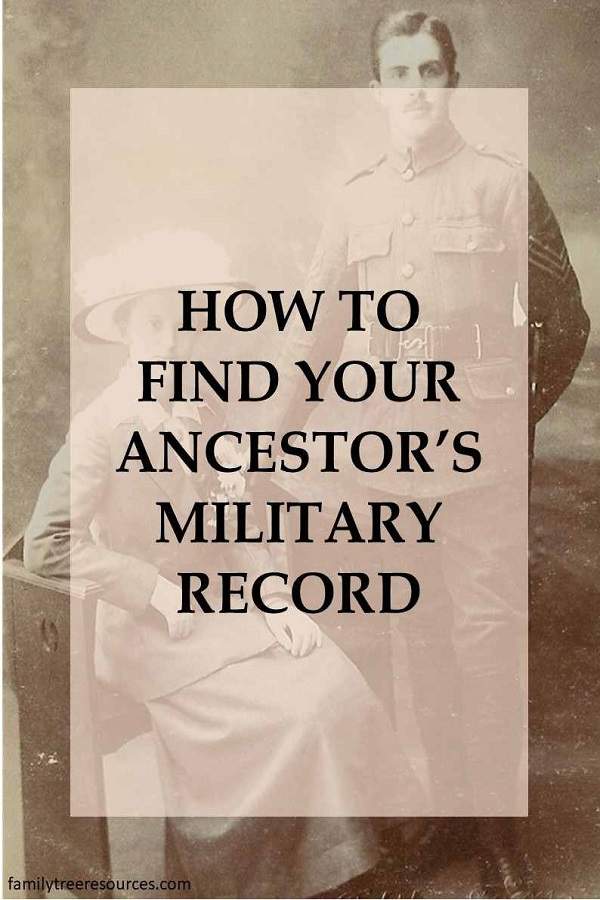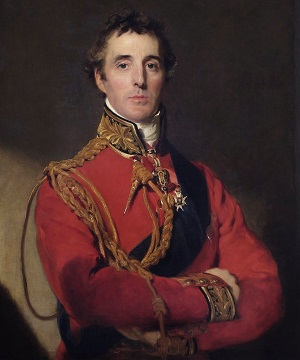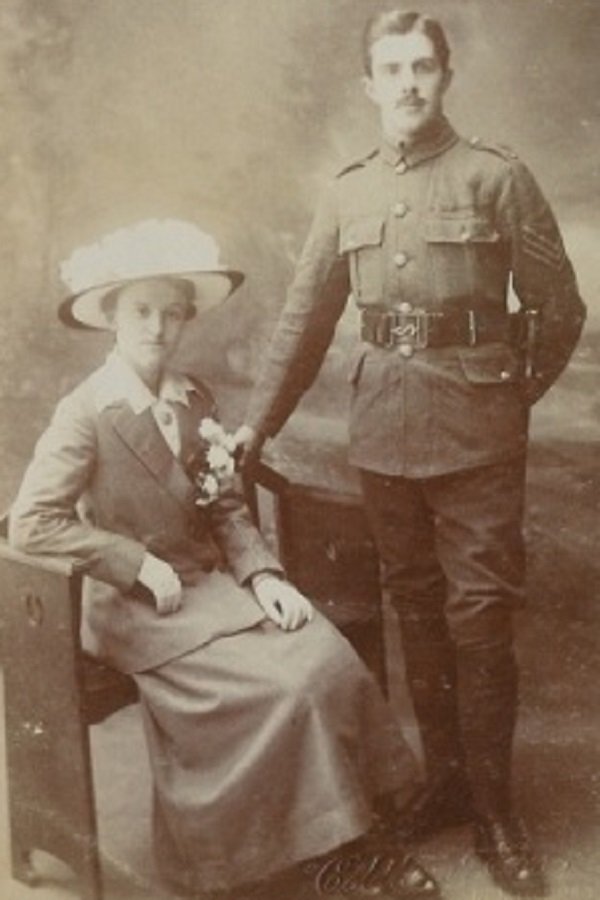
Many military records are available at the National Archives, located in Kew, Richmond, Surrey, TW9 4DU. If travelling by tube, the nearest station is Kew Gardens (District line). If travelling by train, the nearest station is Kew Bridge.
Some buses stop nearby, which include routes R68, 65, 237, 267 and 391. Further information regarding modes of transport are available via Transport for London.
Military records can help you to determine when and where your ancestor served, and whether he was in the enlisted ranks or an officer. Clues can be found in old newspaper articles, diaries or scrapbooks or old family bibles.
If you have a photograph of your ancestor in uniform, this can also be used to determine the regiment he served in. If your ancestor was killed whilst he was serving, the gravestone could also give details of his service in the military.
Military records may include enlistment or discharge papers, pension records, prisoner rolls or muster rolls. If your ancestor was awarded a campaign medal, records can provide details of a soldier’s service number and unit.
The records of campaign medals can be found on Ancestry, but please be aware that they do make a charge to people using this service.
The Index can be searched by name, regimental (service) number and regiment. Some soldiers may have received medals for gallantry and praiseworthy service.
The Army List
If your ancestor was a member of the Armed Forces, the Army List may be of use. This can help you to obtain the broad outline of an Army Officer’s career.
The National Archives holds Manuscript Army Lists from 1702 to 1752. They also hold the Official Army List first published in 1740. They were then published annually from 1754 to 1879 and quarterly from 1879 to 1922.
These Lists can confirm the officer’s service, his army regiment and any previous regiments he may have served in.
Household Cavalry Service Records 1799-1920
If your ancestor served in the Household Cavalry, you can peruse the service records at the National Archives for non-commissioned officers and other ranks who were discharged between 1799 and 1920.
Please be aware, however, that a fee is chargeable if you wish to download a copy of a service record.
Regiments included in these records include the Life Guards, Royal Horse Guards and Household Battalion.
The records may contain details of the individual’s regiment and rank, comments made about him, his next of kin and any medical reports or pension details.
Army Discharge Papers
Should you have a relative who was a member of the Armed Forces, but who was not an officer, it is prudent to consult his discharge papers and/or pension record.
The National Archives hold discharge papers from 1760 to 1913 and pension records from 1702 to 1913. The papers are arranged alphabetically from 1883.
It is more difficult to trace military personnel in discharge papers before this date as the names were then arranged by regiment so you are required to know the regiment they served in.
The papers can give a lot of detail listing soldiers’ place of birth, age on enlistment, their next of kin and details of their appearance. A service schedule before 1883 is usually only for a man who received a pension on discharge.
My ancestor, Thomas McJannett, fought at the Battle of Waterloo, but suffered wounds to his right leg and left thigh and 10 other injuries.
His discharge paper stated that he enlisted on 14 April 1805 and was discharged from the Army on 31 August 1816.
Information from the discharge paper disclosed that he was born in Clapham, Surrey, was approximately 28 years old when he was discharged, was 5 feet 4 inches in height, had brown hair and grey eyes and had a brown complexion.
Thomas settled in Narborough, Leicestershire, and went on to have 5 children. He died on 22 June 1862.
Napoleonic War Records

Army of Reserve 1803
Passed in 1803, the Army of Reserve Act meant that each county in England, Wales, Ireland and Scotland had to state that men would form an Army of Reserve that would be called to action if there was a threat that the country would be invaded.
Men aged 17 to 55 were eligible to enlist and were each given a sum of 2 guineas on enlistment.
The men enlisted for a period of 5 years, but only had to serve in Britain. Each reserve was allocated to a specific regiment or reserve battalion.
Details of these records are available on FindmyPast.
Regimental Indexes 1806
These records cover the Foot Guards, Cavalry, Royal Waggon Train and 1st-50th Regiments of Foot. Information contained in these records include:
- Full name
- Date of enlistment
- Rank
- Regiment
- Reference Number at the National Archives
Details of these records are available on FindmyPast.
Foot Guards Attestation Papers 1775-1817
This index many contain information about your ancestors, which includes:
- Full name
- Place of birth
- Enlistment date
- Other remarks
These attestations are held at Grenadier Guards Regimental Archives, Wellington Barracks, Birdcage Walk, London, SW1E 6HQ. You have to pay a research fee to access the records, and a letter of introduction is also required.
These records are available on FindmyPast.
Muster Rolls
Muster Rolls and Regimental Pay Lists can be a good source of information as they list those present at regimental musters, and were compiled either monthly or quarterly for accounting purposes.
They also list their careers, any absences, enlistment and/or departure dates. If your ancestor did not receive a pension, this could be the only place your ancestor is mentioned.
The date and place of the muster is also recorded so you can trace an individual’s army career in more detail. You can view the period between 1730 and 1898 at the National Archives.
The General Series 1732-1878 is held in WO12, the Artillery 1708-1878 is kept in WO10, WO69 and WO54, the Engineers 1816-1878 in WO11 and WO54, and the Militia and Volunteers 1780-1878 in WO13 and WO68.
The muster of British troops sent to the Scutari Depot in the Crimean War 1854-1856 are kept in WO14.
You do have to know the regiment your ancestor served in to trace his career using the muster rolls. Each regiment’s muster rolls are kept together and are arranged annually.
The records of some of the children of the soldiers may be found in the papers of Duke of York’s School and the Royal Hibernian School from 1801 are kept in WO143.
If your ancestor served during the period 1878-1898, the muster rolls and pay lists can be found in WO16. If you are searching after 1888, please bear in mind that no pay lists exist from this period and muster rolls themselves were not kept from 1898.
Muster Rolls covering 1812-1817 have been made available on Ancestry, and can searched by name, date and regiment. A keyword search box is also available, so you can search by keyword if you wish.
This period also covers the Battle of Waterloo so you can determine whether or not your ancestor fought in this battle.

My grandaunt Mabel Florence Watts (nee Dunkley) and her husband Harold Bevis Watts on 21 November 1916. Harold was unfortunately killed in action on 1 May 1917 aged 23 and is commemorated on the Arras Memorial.
He was the son of Bevis and Ada Watts of 1 Bowden Road, St James, Northampton. His wife Mabel lived in 38 Greenwood Road, St James, Northampton.
Harold served in “D” Coy. 6th Battalion of the Northamptonshire Regiment, his service number being 28242.
Should you have an ancestor who was killed in the First or Second World War, you can search for the person using the Commonwealth War Graves Commission’s Casualty Database.
Please also view my guide to campaign medals that may have been awarded to your ancestor. I have also prepared lists of World War One and World War Two Medals.
If you believe your grandfather served in WW1, please read my article: how to discover if your grandfather served in WW1.
My Ancestor Served in the First World War
If your ancestor served in the First World War, it is possible to obtain a copy of a service record between 1914 and 1920 on Ancestry (covers 1764 -1932) and FindmyPast, but please be aware that a fee is chargeable to access these records.
Records available on these sites include service records (WO373 at the National Archives), pension records (WO364) and campaign medal cards.
These databases include details of soldiers discharged between 1914 and 1920, soldiers killed between 1914 and 1920 and soldiers who died of disease or wounds sustained during the war.
These records do not include records of soldiers who continued to serve after 1920 or soldiers who transferred to another service.
The service records also include regiments such as the West African Field Force, the British West Indies Regiment and the West India Regiment.
Many First World War Service Papers were unfortunately destroyed in 1940, however, so you may have to search through medal records to discover a soldier’s service number and regiment.
If you know the unit your ancestor served in, you may find that your ancestor is mentioned in the unit war diary. Only officers are actually mentioned by name in these diaries, however.
Silver War Badge Roll 1914-1920
If your ancestor was discharged because of illness or injuries sustained fighting in the war at home or overseas, they will have received the silver war badge. It is possible to search this roll on Ancestry by their name, regimental number or badge number.
How to Access Military Records After 1920
If your ancestor or someone you are researching served in the military after 1920, you can apply for a copy of their service record, but only if they are deceased, and you are their next of kin, or have the next of kin’s permission to obtain them.
If you have a general research interest, however, you will not be able to obtain full access to their service record unless they died over 25 years ago.
Before you apply, you should ensure that you know the person’s name, date of birth and service number.
You have to fill in a request form, from which there are two options to choose from. One form is used if you are the next of kin or have their consent, the other is used if you are not the next of kin or do not have the next of kin’s consent.
You also have to fill in a search form, which will be different depending on whether the person served in the Royal Navy or Royal Marines, British Army or Royal Air Force.
You are required to send both the request form and the search form, along with the fee charged for the record, to the address described on the form.
Information on the Service Record
The details in the service record can vary depending on the details available, but could include:
- Full Name
- Service Number
- Rank
- Regiment
- Date of birth
- Place of birth
- Enlistment date
- Discharge date
- Date of death (if they died whilst in service)
- Medals awarded
- Details of their service (only if they died more than 25 years ago unless you are the next of kin or have their consent)
If the information contained in the service record could impact the security of the Armed Forces, your application may be refused.
RAF Military Records
To begin the search for an airman/woman in an RAF service record, you need to know his/her year of entry and/or discharge. The National Archives has details of airmen or airwomen’s service in AIR 78 (name indexes) and AIR 79. AIR 79 records contain details regarding:
- Date and place of birth
- Physical appearance
- Religion
- Next of kin
- Any possible spouse and/children
- Enlistment date
- Promotions
- Units served in
- Medals awarded
- Discharge date
Royal Air Force officers’ service records 1918-1919 can be searched online at the National Archives. If your ancestor served in the RAF during the First World War (1914-1918), you should be able to obtain his service record in these records.
These records were created when the RAF was formed in April 1918, but do contain details of any earlier service in the Royal Flying Corps or Royal Naval Air Service.
To see if your ancestor is indeed included in these records, you should search the records by using Discovery, the National Archives online catalogue. You should fill in their first and last names and the date. These records contain details regarding:
- Full name
- Date of birth
- Birthplace
- Next of kin
- Occupation
- Commission date
- Promotions
- Units served in
- His date of death, date the officer relinquished his commission, or his date of retirement.
The records may also contain the following details, if appropriate:
- Information regarding specialist courses your ancestor attended
- Type of aircraft flown
- Honours and/or awards and the date they were included in the London Gazette
If you cannot find your ancestor’s service record, you can search the Operations Record Books and Combat Reports, which were updated daily and contain details of a squadron’s life and of other units within the structure of the RAF.
These books may describe what actions an airman or officer took during the war, but usually only the activities of the whole unit are recorded, with individuals not often mentioned. These books can contain details of:
- Nominal rolls
- Officers lists
- Promotions
- Transfers
- Awards
To search these books, you do need to know the squadron your ancestor served with.
If the airman/woman you are looking for was discharged after 1922 his/her service schedule will still be with the RAF. Veterans UK may be able to help you in your quest to obtain his/her service record.
If you want to find out more about a RAF airman’s/woman’s career after 1913 then the in-depth research guide, RAF, RFC and RNAS personnel after 1913 might be useful.
Merchant Navy Records
If you have a relative who served in the Merchant Navy, you may find the following research guides helpful:
- Merchant Seamen serving between 1835-1837, 1853-1928, and post 1918.
- Merchant Seamen’s medals and honours
- Registration of Merchant Ships
Royal Navy Records
If a relative served in the Royal Navy as an officer or a rating, you may find the in-depth research guide entitled Royal Navy commissioned and warrant officers: further research helpful.
It is also possible to discover more about a military career in the National Army Museum, which is based in Royal Hospital Road, Chelsea, London, SW3 4HT. If travelling by tube, the nearest tube station is Sloane Square, which is approximately 10 minutes walk. If travelling by train, Victoria is 20 minutes walk. For people travelling by bus, bus 170 stops outside the museum.
Another museum you may find of use is the Imperial War Museum, which is situated in Lambeth Road, London, SE1 6HZ. If travelling by tube, the nearest tube stations are Lambeth North (Bakerloo line – 5 minutes walk), Waterloo (Bakerloo, Jubilee and Northern lines – 10-15 minutes away) and Elephant & Castle (Bakerloo and Northern lines – 10-15 minutes away).
If travelling by bus, bus routes 3, 12, 53, 59, 148, 159, 344, 360, 453 and C10 all stop near to the museum. The nearest train stations are London Waterloo and Waterloo East (15 mins) and Elephant and Castle (15 mins).
